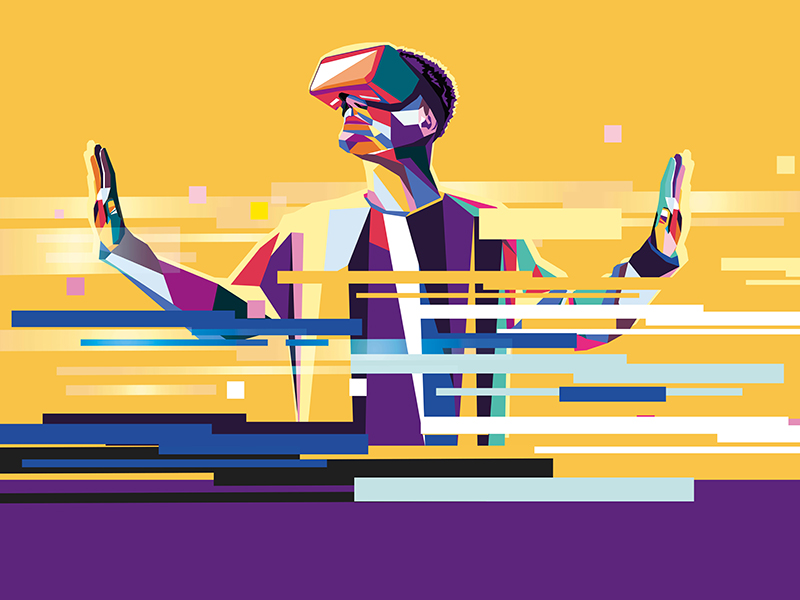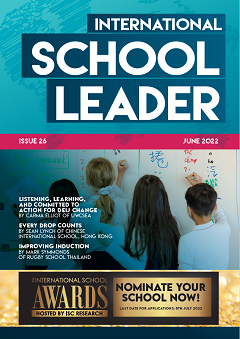By Stuart Douglas
In the ever-evolving landscape of education, it has become imperative for schools to adapt to new technologies and innovative methods to enhance the learning experiences of students. Over the past three years, our design and technology (D&T) department in both the senior and prep schools embarked on a groundbreaking journey into the world of augmented reality (AR). This initiative was driven by a desire to provide students with a dynamic platform to review designs, simulate real-world environments and gain valuable insights from experts. In the wake of the disruptions caused by COVID-19, this AR initiative has not only bridged the gap but has also opened new doors for our students in the realm of D&T.
This AR initiative has proven to be a game changer, not only in preserving the essence of design coursework but also in empowering students to become more innovative and resourceful problem-solvers.
Augmented reality: a solution in times of disruption
The disruption caused by the COVID-19 pandemic posed unique challenges for schools worldwide. Among the aspects significantly impacted was the traditional process of students reviewing real-life manufactured designs, which is a critical component of coursework, particularly for IGCSE and A Level students, accounting for up to 30% of final coursework grades. Faced with this challenge, I sought innovative solutions – and that’s when AR entered the scene.
A Level students, for instance, leveraged AR from 3D CAD free software Onshape as well as rendering software Keyshot and Shapr3D, to create virtual scenes simulating their gym equipment designs in use. AR was a new concept, but it was an add-on to the 3D CAD software the students were already using which enabled a very fast learning process. This not only allowed them to visualise their designs in action but facilitated the collection of genuine client feedback from user groups. Collaboration between students, with one virtually interacting with the AR model to assess design effectiveness, became a reality. The results were compelling and provided a rich visual catalogue for coursework submissions.

Photo: Rugby School Thailand
Expanding horizons with AR
One of the most remarkable aspects of this AR initiative has been its ability to connect our students with a wider community of experts and peers. By digitally bringing their designs to life in real-world settings, students have had the opportunity to seek opinions and guidance from professionals beyond our school’s boundaries. This has led to a deeper understanding of product designs before manufacturing. For instance, last year an A Level student used her AR model to present her design concepts to teachers in our pre-prep and nursery schools, receiving valuable insights and even creating an interactive version for the children to engage with on iPads. This made significant improvements to her design work at various stages, resulting in an innovative concept which was awarded an A* grade on external assessment.
The integration of AR with our 3D CAD software has transformed the way students comprehend 3D forms, especially when learning advanced sketching skills. Explaining the effects of light on 3D forms has traditionally been challenging, but AR has provided a revolutionary approach, making the subject more adaptable and engaging. Consequently, students have developed enhanced rendering and communication skills at undergraduate standard in many cases.

Photo: Rugby School Thailand
AR: empowering independent problem-solving
The ability to share AR design files via email or Airdrop has empowered students to independently problem-solve. They can virtually test products in their intended environments, showcase their work to clients and seek real-time feedback, resulting in iterative improvements. This approach has not only fostered creativity but also allowed students to resize and relocate models within selected scenes, share designs for peer review and collaborate effectively with clients.
Furthermore, AR has bridged geographical gaps, allowing examiners based in different countries to gain a comprehensive understanding of each final design and the process behind it. The impact of AR on D&T coursework testing is undeniable, revolutionising the way we evaluate student projects.
AR: paving the way for future innovators
Recognising the profound benefits of AR in our senior school, we have extended its use to our prep school students as early as year 5. This early exposure enables students to witness their sketched ideas come to life, deepening their understanding of 3D form. We have seamlessly integrated 3D models into our D&T websites, enabling students to interact fully with them using various devices. Designs are uploaded through AR code as interactive documents or via QR codes for easy access, meaning that students can scan models either in the classroom or at home.
Currently, we are utilising AR to develop a new year 8 table project centred around patterns. We have modelled a range of different table designs, rendering them using tropical hardwoods, and then used AR to place them in situ to demonstrate ideas to the students. This approach has not only saved countless hours compared to traditional methods but has also left students astounded by the realism and effectiveness of AR models, often indistinguishable from real-life objects. This time-saving approach is priceless for D&T teachers as it allows us to produce many different models and examples for students that would typically take several years to manufacture, given normal school constraints. It also costs very little as the 3D CAD software is free, including being able to share as an AR model, and just an educational cost if the model is to be rendered in realistic materials, which is a development that we have chosen.

Photo: Rugby School Thailand
Conclusion
The incorporation of AR into our D&T curriculum has ushered in a new era of learning and creativity. It has enabled students to bridge physical and geographical gaps, transforming how they interact with and understand 3D forms, simulate real-world scenarios and collaborate with peers and experts. This AR initiative has proven to be a game changer, not only in preserving the essence of design coursework but also in empowering students to become more innovative and resourceful problem-solvers. As we continue to expand the horizons of AR in our educational practices, we look forward to nurturing the next generation of designers, makers and technologists who will shape our future.
Recommendations on how to adopt AR in your school’s D&T department:
- Allow D&T teachers and other relevant staff to attend 3D CAD PD courses to upskill. Once they know how to use 3D CAD, they can easily use AR to create a wide range of models that can be shared with students.
- Look at opportunities for embedding AR into school websites, such as department websites, to aid student understanding of complex 3D forms. This can start as early as year 3 or year 4, as all students need to do is scan a QR code with a device to see the AR model come to life.
- Look for free software to allow 3D CAD modelling, such as Onshape or Shapr3D (iPad), which will allow for students to easily access AR in the classroom or at home.
- Make a small investment into a piece of rendering software or an app, such as Keyshot or Cadmio, to allow students to apply materials and render to a high photorealistic resolution on an iPad or laptop device.

Stuart Douglas is a highly successful leader of Design & Technology, previously working in the UK at an outstanding academy as Head of a nationally recognised D&T faculty, and from 2018 as Head of D&T (Senior) at Rugby School Thailand. You can contact Stuart directly on LinkedIn.






